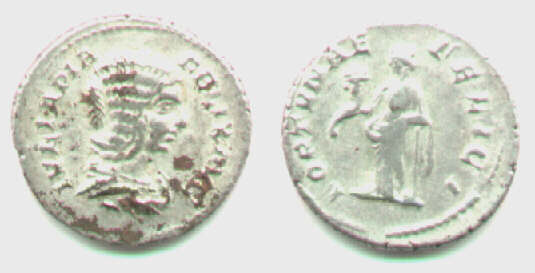 19 mm. 5:30. 3.12 grams.
19 mm. 5:30. 3.12 grams. First is
an unusual good-silver imitation, followed by the more-common fourrées
and then casts.
 18-17mm. 6:00. 3.01 grams.
18-17mm. 6:00. 3.01 grams.  19 mm. 5:30. 3.12 grams.
19 mm. 5:30. 3.12 grams.
Hybrid of not-quite official style.
The obverse legend exists only under Cacacalla's sole reign (211-217),
but
the reverse belongs to the period 196-211.
IVLIA PIA FELIX AVG
/FORTVNAE FELICI, Felicitas standing left holding
cornucopia,
resting left on rudder
Sear 1837 var. RIC -- but 552 has this reverse with IVLIA
AVGVSTA, page
167, plate 9.5 "196-211"
BMC (S&C) reverse of 24, plate 27.12 (3.62 grams).
Under microscopic examination the surface shows a very thin layer of
silver
over copper -- but not the appearance of a foil sheet. The surface
seems
different from that of a typical Republican silver-plated denarius.
Next, fourrées, then
casts.
Fourrées are struck from dies engraved by forgers. The
face
is always the hardest thing to draw, and you can see that the engravers
had
a hard time getting the face of Julia Domna right. Compare the next
several
fourrées to the casts that follow. Because casts were of casts
from
official coins, the style of cast imitations is usually perfect and
certainly
much better than most fourrés.
A stern Julia Domna fourrée. Although the engraving is good, it
does
not duplicate official style.
IVLIA AVGSTA [sic, the second "V" of "AVGVSTA" was not engraved]
/PM TP XVI COS III ..
This is a hybrid. The obverse is common for Julia Domna, but the
reverse
belongs to Septimius Severus, BMC (S&C) 562, plate 42.4, AD 208.
Many fourrées are hybrids that use obverse and
reverse
types that were never officially matched.
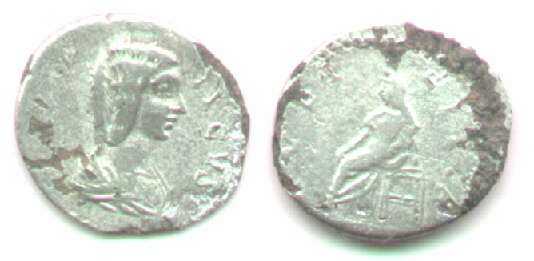 19 mm. 6:00. 2.71 grams.
19 mm. 6:00. 2.71 grams.
A fourrée with a vapid portrait and uninspired reverse engraving.
Compare
the reverse to the next piece.
[IVLI]A AVGVSTA
/PVDI - CITIA, Pudicitia seated left.
Prototype: Sear 1848. BMC (S&C) 74, page 166, plate 28.17 of
Rome.
There are similar eastern types but this style is western.
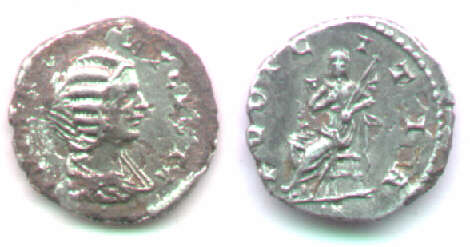 17 mm. 6:00. 2.55 grams.
17 mm. 6:00. 2.55 grams.
Boldly engraved. The reverse is in excellent style.
[IVLIA] AVGVSTA
/PVDICTIA [as the previous coin, but much better
engraved]
Prototype: Sear 1848. BMC (S&C) 74, page 166, plate 28.17 of
Rome.
There are similar eastern types but this style is western.
Hill
1165
or 1298 (both AD 211). 1165 has the correct obverse legend, but not
the
scepter, and 1298 is vice versa.
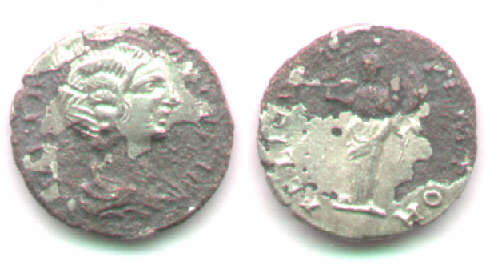 18 mm. 6:00. 2.64 grams.
18 mm. 6:00. 2.64 grams.
Good, but not quite official, style. Much plating gone.
IVLIA AVGVSTA
/FELICITAS TEMPOR, Felicitas holding caduceus
Protypes: Hybrid with reverse of Geta, BMC 683, plate 45.1,
AD198-200, eastern mint.
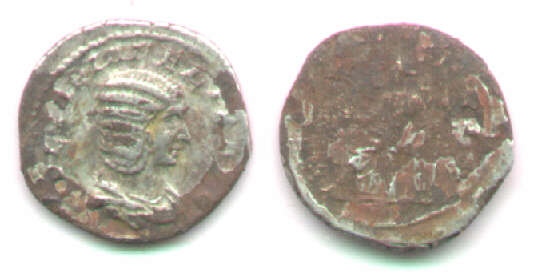 18 mm. 5:30. 2.88 grams.
18 mm. 5:30. 2.88 grams.
Extremely thin silvering on a coin of excellent style. I wonder if
this
is not a fourrée, rather a cast which was then somehow silvered.
The
style is almost too good for a fourrée.
IVLIA PIA FELIX AVG
/seated female left (in good style, but too corroded
to
identify the legend)
This obverse legend was used for Julia Domna under Caracalla.
 18 mm. 6:00. 2.95 grams.
18 mm. 6:00. 2.95 grams.
A bold, but cruder portrait.
IVLIA AVGVSTA
/FELICITAS, Felicitas standing left with caduceus
Prototype: RSC 47. BMC (S&C) 22, page 160, plate 27.11,
AD
198-209.
Cast imitations:
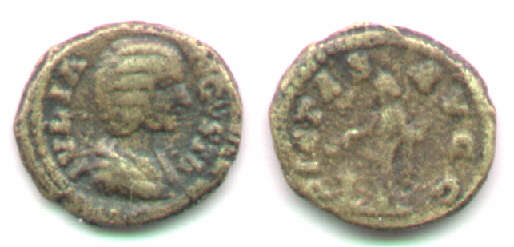
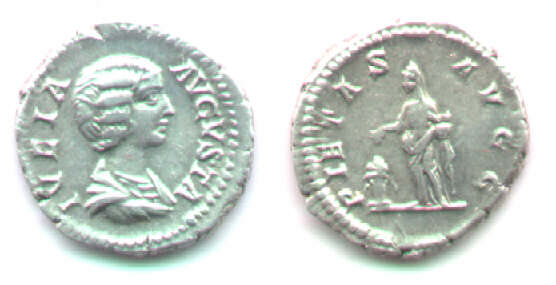
Imitation: Cast, no traces of silvering. 18-16 mm. 6:00. 2.60
grams.
Prototype: AR20. 6:00. 3.45 grams.
Unusually brassy. Most casts are in base gray metal, as are the
following pieces.
IVLIA AVGVSTA
/PIETAS AVGG, Pietas standing left, sacrificing at
altar
References: Prototype is Sear (old) 1846. RIC (SS) 572, plate 9.8
"196-211".
BMC (S&C) 62, "196-211" plate 28.13.
I don't know what the counterfeiters did to make a
cast
piece like this have a silver surface that could be deceptive. It
cannot
properly be called the core of a fourrée because it was not
struck
with silver plating.
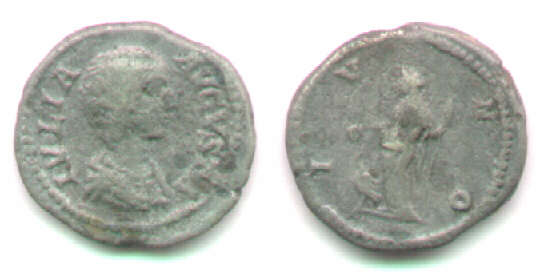 19 mm. 6:00. 3.03 grams.
19 mm. 6:00. 3.03 grams.
Gray metal. Note the weakness which is typical of casts. They are
rarely bold. They cannot have more depth of relief than the coins they are
cast
from, and they lose details in the process. Contrast this with
fourrées, which are often as bold as the originals.
IVLIA AVGVSTA
/IVNO, Juno standing with peacock at feet.
Prototype: BMC (S) 38-39 page 162, plate 27.19, AD 198-209.
RSC 82. Hill 1029 (AD 209)
 19 mm. 12:00. 2.78 grams.
19 mm. 12:00. 2.78 grams.
Another dark metal cast. Note the official style, which is typical of
casts.
IVLIA AVGVSTA
/PVDICITIA
Prototype: RIC 576, page 170. BMC 613-616, page 278, "Eastern mint,"
plate
43.4.
Also BMC 72-74 at Rome. Plates 28.16 and 28.17 have fewer
hair
ridges. 28.17 is called "base?" for being 2.49 grams.
The same type was issued at Rome, but is "R2" there according to Hill
#701.
A small cast. Casts are usually slightly smaller in diameter than the
originals
used to make the molds. However, thickness is not easily controlled in
casting
because the two halves of the mold may not fully meet.
IVLIA AVGVSTA
/PVDICITIA
Type as above, but possibly the western style.
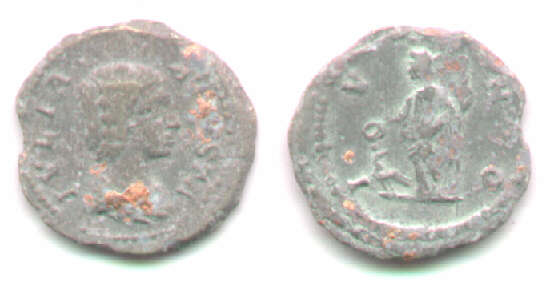 19 mm. 12:00. 2.60 grams.
19 mm. 12:00. 2.60 grams.
Gary metal. The bright copper is encrusted on the surface and is not below the
surface.
This is a cast and not a fourrée.
The reverse shows a very thin
shiny
lighter covering, possibly intended to imitate silver, but no longer
effective.
IVLIA AVGVSTA
/IV - NO, Juno standing, peacock at feet.
Prototype: Sear --. BMC (S&C) 39, page 162, plate 27.19.
RIC 559, page 168, plate IX.6 has a very similar reverse die.
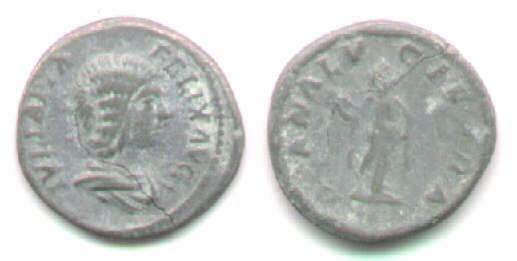 18 mm. 6:00. 2.31 grams.
18 mm. 6:00. 2.31 grams.
Gray metal. Flan crack through 80% of the flan, starting at 5:00.
IVLIA AVGVSTA
/DIANA LVCIFERA, Diana standing left, holding torch
Sear 1835.
Again, note the weakness of the cast pieces compared to the
struck
pieces.
Return to the page on Severan imitations.
Return to the main Table of Contents
page on Roman
imitations.
Go to the Table of Contents page of this whole site, including coins that are not imitations.